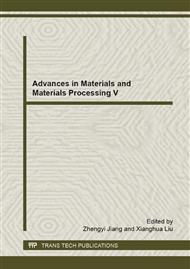p.631
p.636
p.641
p.647
p.651
p.655
p.662
p.666
p.673
The Role of Hierarchical Micro-Morphology in the Wetting Property of Moth (Geometrinae) Wing Surface
Abstract:
The micro-morphology of the moth wing surface was characterized by a scanning electron microscope (SEM). The contact angle (CA) and sliding angle (SA) of water droplet on the wing surface were measured by an optical CA meter. The wetting mechanism was discussed from the perspective of biological coupling. The moth wing surface is of superhydrophobicity (CA 143~156°) and low adhesion (SA 1~4°), and displays multiple-dimensional rough micro-morphology. The scales play a crucial role in the complex wettability of the wing. The average rate of CaCO3 pollution removal from the wing surface is as high as 87.3%. There is a positive correlation (R=0.8777) between pollution removal rate and roughness index of the wing. The cooperation of chemical composition and micro-morphology contributes to the special wettability and outstanding self-cleaning performance of the wing. The moth wing can serve as a template for biomimetic design and preparation of novel interfacial material with multi-functions.
Info:
Periodical:
Pages:
651-654
Citation:
Online since:
March 2015
Keywords:
Price:
Сopyright:
© 2015 Trans Tech Publications Ltd. All Rights Reserved
Share:
Citation:


